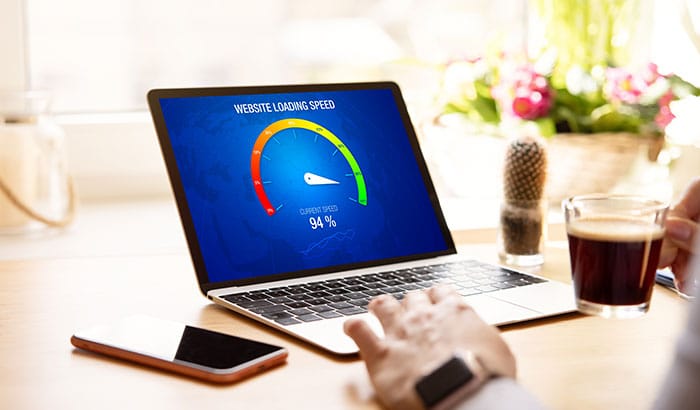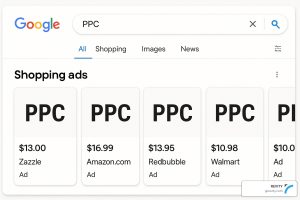In today’s digital age, website speed is more important than ever. Slow-loading websites can lead to poor user experience, lower search engine rankings, and decreased conversions.
To ensure optimal website performance, it’s crucial to measure site speed and take steps to improve it. In this blog post, we’ll explore the importance of site speed for conversion rate and provide practical tips on measuring and improving website speed.
By implementing these tips, you can significantly improve website speed and performance, increasing conversions and business success.
To start, let’s look at website speed and conversion rate and how they are related.
What Does “Website Speed” Mean?
Website speed, also known as website performance, refers to how quickly a web page loads and becomes fully functional in a user’s browser. It measures the time it takes for a website to display all its content, including images, videos, and interactive features.
Website speed is impacted by a variety of factors, including server response time, page size, and the number of HTTP requests required to load a page.
What Is Your “Conversion Rate”?
Conversion rate is a metric used to measure the percentage of website visitors who complete a desired action, such as making a purchase, filling out a form, or subscribing to a newsletter. It is calculated by dividing the number of conversions by the number of visitors and multiplying the result by 100 to get a percentage.
For example, if a website has 100 visitors and 10 make a purchase, the conversion rate would be 10%. Conversion rate is an important metric for businesses because it directly impacts revenue and can be used to measure the effectiveness of marketing campaigns and website design.
You can improve your bottom line and achieve your goals more effectively by optimizing your website and marketing strategies to increase conversion rates.
Why Site Speed Matters for Conversion Rate
There are four primary reasons why site speed matters for conversion rate: user experience, perception of credibility, search engine ranking, and mobile optimization. Let’s look at each of these.
1. User Experience
Slow-loading websites can lead to a poor user experience, which can frustrate visitors and cause them to abandon the website. A study by Google found that as page load time increases from one second to five seconds, the probability of bounce (a visitor leaving the website without taking any action) increases by 90 percent. Visitors are more likely to leave if your website takes too long to load without converting.
2. Perception of Credibility
Perception of credibility is crucial in today’s digital age. With so much information available online, consumers are constantly bombarded with messages from businesses and individuals. As a result, they have become more discerning about the sources they trust.
A slow website that appears unprofessional can quickly lose credibility in the eyes of consumers, leading to decreased trust and lower conversion rates. On the other hand, a website that loads quickly can enhance a business’s credibility and increase conversions.
By investing in website design and user experience, businesses can build trust with their audience and establish a strong online presence that sets them apart from the competition. In today’s digital landscape, the perception of credibility is essential for business success.
3. Search Engine Ranking
Website speed is also a ranking factor for search engines like Google. In 2010, Google announced that site speed would be a factor in its search ranking algorithm. This means that slow-loading websites may rank lower in search results, which can decrease traffic and conversions.
4. Mobile Optimization
Mobile optimization is crucial for businesses that want to reach customers on the go. Mobile users often rely on slower or less reliable internet connections, meaning site speed is even more important for mobile optimization.
According to Google, 53% of mobile users will abandon a website that takes longer than 3 seconds to load. This means that if your website is slow on mobile, you could miss out on many conversions.
How to Measure Site Speed
You may be wondering exactly how fast your website is. The good news is that there are tools you can use to figure that out. Let’s look at a few.
1. Google PageSpeed Insights
Google PageSpeed Insights is a free tool that analyzes the content of a web page and generates suggestions to make that page faster. It provides both a desktop and mobile score and offers suggestions on how to improve the website’s speed and performance. The tool also provides a detailed breakdown of the website’s performance, including load time, time to first byte, and other important metrics.
2. GTmetrix
GTmetrix is another free tool that analyzes website speed and performance. It provides a detailed report on page speed, YSlow score, and other important metrics. The tool also provides recommendations on how to optimize the website for faster loading times.
3. Pingdom
Pingdom is a paid tool that offers real-time monitoring of website performance. It provides detailed reports on website uptime, load time, and other important metrics. The tool also provides alerts and notifications when the website is down or experiencing performance issues.
4. WebPageTest
WebPageTest is a free tool that allows you to test website speed and performance from multiple locations worldwide. It provides a detailed report on website speed, performance, and other metrics. The tool also allows you to simulate different connection speeds and devices to test website performance under different conditions.
5. Lighthouse
Lighthouse is a free, open-source tool that is built into Google Chrome. It provides a detailed report on website performance, accessibility, and other important metrics. The tool also provides recommendations on how to optimize the website for faster loading times.
Just keep in mind that these metrics are for the Google Chrome browser; you might get different results from different browsers. Still, it’s an excellent tool to use.

How to Improve Site Speed
The good news is that there are several things you can do to improve your website’s speed. Things like optimizing images, minifying CSS and JavaScript, using a CDN, etc., can all help.
1. Optimize Images
Images are often the largest files on a web page, significantly slowing page load times. To optimize images, you can compress images using tools like Photoshop, TinyPNG, or Squoosh. You can also specify image dimensions and use responsive images to ensure the correct size image is loaded for each device.
2. Minify CSS and JavaScript
Minifying CSS and JavaScript files can reduce their file size and improve page load times. You can use tools like MinifyCSS or UglifyJS to automatically remove unnecessary characters from CSS and JavaScript files.
3. Use a Content Delivery Network (CDN)
A CDN is a network of servers that are distributed around the world. You can store website content on multiple servers using a CDN, improving visitor page load times in different locations. Popular CDN providers include Cloudflare, Amazon CloudFront, and Akamai.
4. Enable Browser Caching
Browser caching allows web pages to be stored on a visitor’s device, improving page load times for repeat visitors. You can add cache-control headers to your website’s HTTP response to enable browser caching.
5. Reduce HTTP Requests
Each file on a web page requires a separate HTTP request, which can slow down page load times. To reduce HTTP requests, you can combine CSS and JavaScript files, use CSS sprites for images, and remove unnecessary files from the website.
6. Use a Fast Web Host
Website hosting plays a crucial role in site speed. The hosting provider determines the server configuration, which can impact the speed and performance of a website.
A good hosting provider will have servers optimized for speed and reliability, ensuring that websites load quickly and efficiently. On the other hand, a poor hosting provider can result in slow loading times, downtime, and other performance issues.
Factors such as server location, server hardware, and server software can all impact website speed. For example, a server located closer to the user will typically result in faster loading times. High-performance hardware and software can help ensure websites load quickly and efficiently.
Why Ongoing Website Maintenance Matters
Besides running tests and optimizing your website, you’ll also want to keep up with its maintenance. Ongoing website maintenance will help ensure fast loading times and provide other benefits for your website. Plus, if you keep up with website maintenance, you’ll quickly notice if something goes wrong. Here are some reasons why ongoing website maintenance matters:
- Security: Websites are vulnerable to security threats like malware and hacking attempts. Ongoing website maintenance can ensure that your website is secure by regularly updating software and plugins, monitoring for security breaches, and implementing security measures such as firewalls and SSL certificates.
- Performance: Over time, websites can become slow and inefficient due to outdated software, broken links, and unused plugins. Ongoing website maintenance can optimize website performance by regularly checking for issues and removing unnecessary elements.
- User experience: A website that is slow, outdated, or difficult to navigate can negatively impact user experience and decrease engagement and conversions. Ongoing website maintenance ensures that your website is user-friendly and up-to-date, providing a positive user experience that encourages engagement and conversions.
- Search engine optimization: Search engine algorithms are constantly changing, and ongoing website maintenance is necessary to ensure that your website is optimized for search engine rankings. This includes regularly updating content, optimizing keywords and metadata, and ensuring your website is mobile-friendly and fast-loading.
Frequently Asked Questions
- Why does site speed matter for conversion rate?
Site speed matters for conversion rate because slow-loading websites can drive users away and negatively impact engagement and sales. Studies have shown that even small increases in page load time can significantly drop conversion rates. A one-second delay in page load time can result in a 7% reduction in conversions. - How does site speed impact user experience?
Site speed significantly impacts user experience because slow-loading websites can frustrate users and lead to higher bounce rates. However, research has shown that users expect websites to load quickly, with 47% of users expecting a web page to load in less than two seconds.
Slow-loading websites can also negatively impact user engagement, with users spending less time on slow-loading pages and interacting less with the content. - How can I improve my website’s speed and conversion rate?
Several ways to improve website speed and conversion rate include optimizing images and other media, minimizing HTTP requests, reducing server response time, and enabling browser caching.
You can also use tools like Google PageSpeed Insights and GTmetrix to identify areas for improvement and optimize your website for speed and performance. - What is the relationship between mobile site speed and conversion rate?
Mobile site speed is critical for conversion rate because mobile users have less patience for slow-loading websites. Studies have shown that mobile users are more likely to abandon a website that takes more than three seconds to load, with 40% of users bouncing away from a slow-loading website.
To optimize mobile site speed and conversion rate, it’s important to ensure your website is mobile-friendly and optimized for mobile devices.
Improve Your Site Speed and Your Conversion Rate With Revity
Website speed is a critical factor in achieving business success. Slow-loading websites can lead to poor user experience, lower search engine rankings, and decreased conversions. By measuring site speed and taking steps to improve it, you can significantly enhance website performance and increase conversions.
At Revity, we specialize in optimizing website speed and improving your conversion rate. Our goal is to help businesses achieve their goals. Our team of experts can analyze your website’s performance, provide recommendations for improvement, and implement solutions to optimize your website’s speed and performance.
Don’t let slow website speed hold your business back – contact Revity today to learn how we can help you achieve your business goals through optimized website speed. Email us at info@gorevity.com or call us at 801.877.3328 for more information.
































